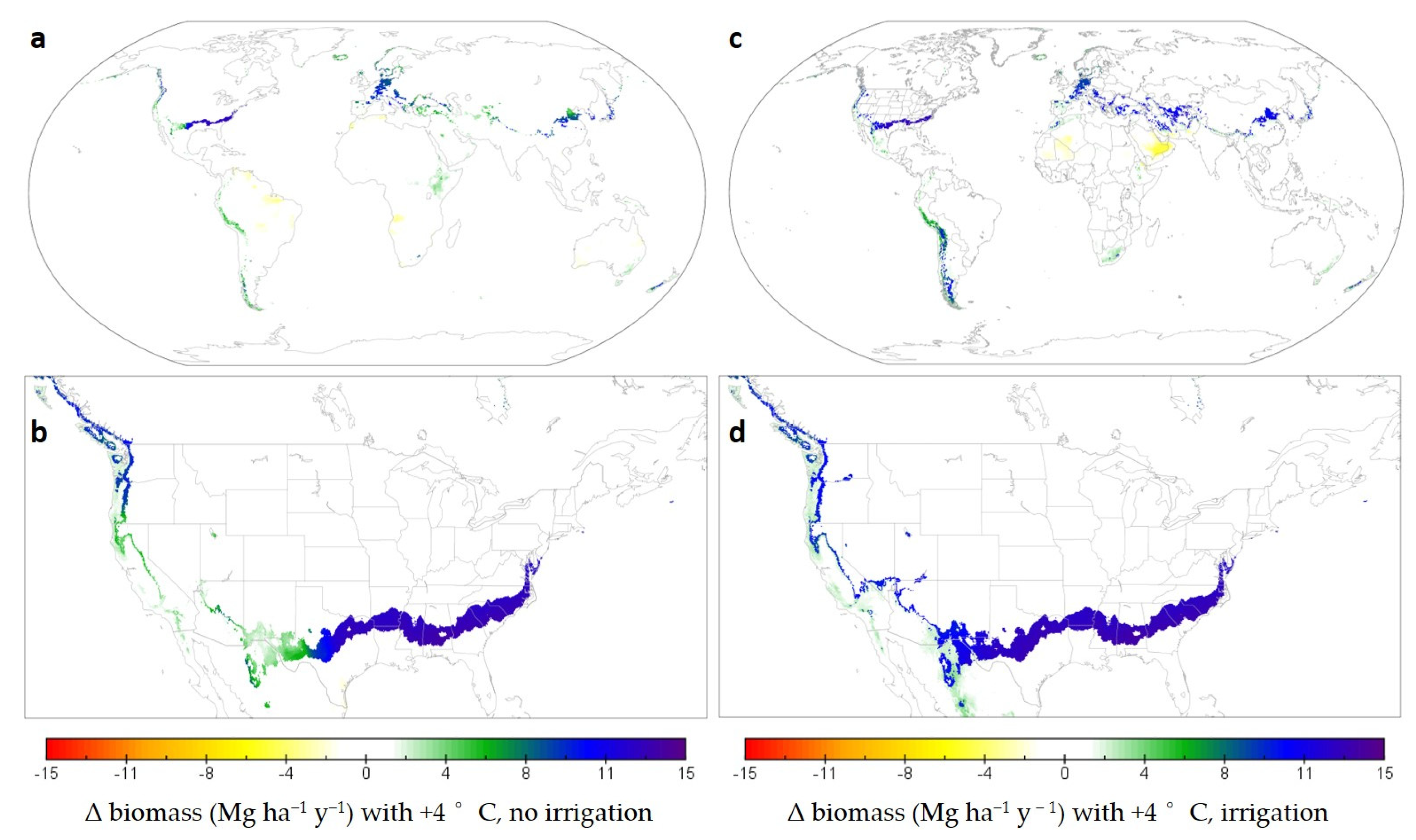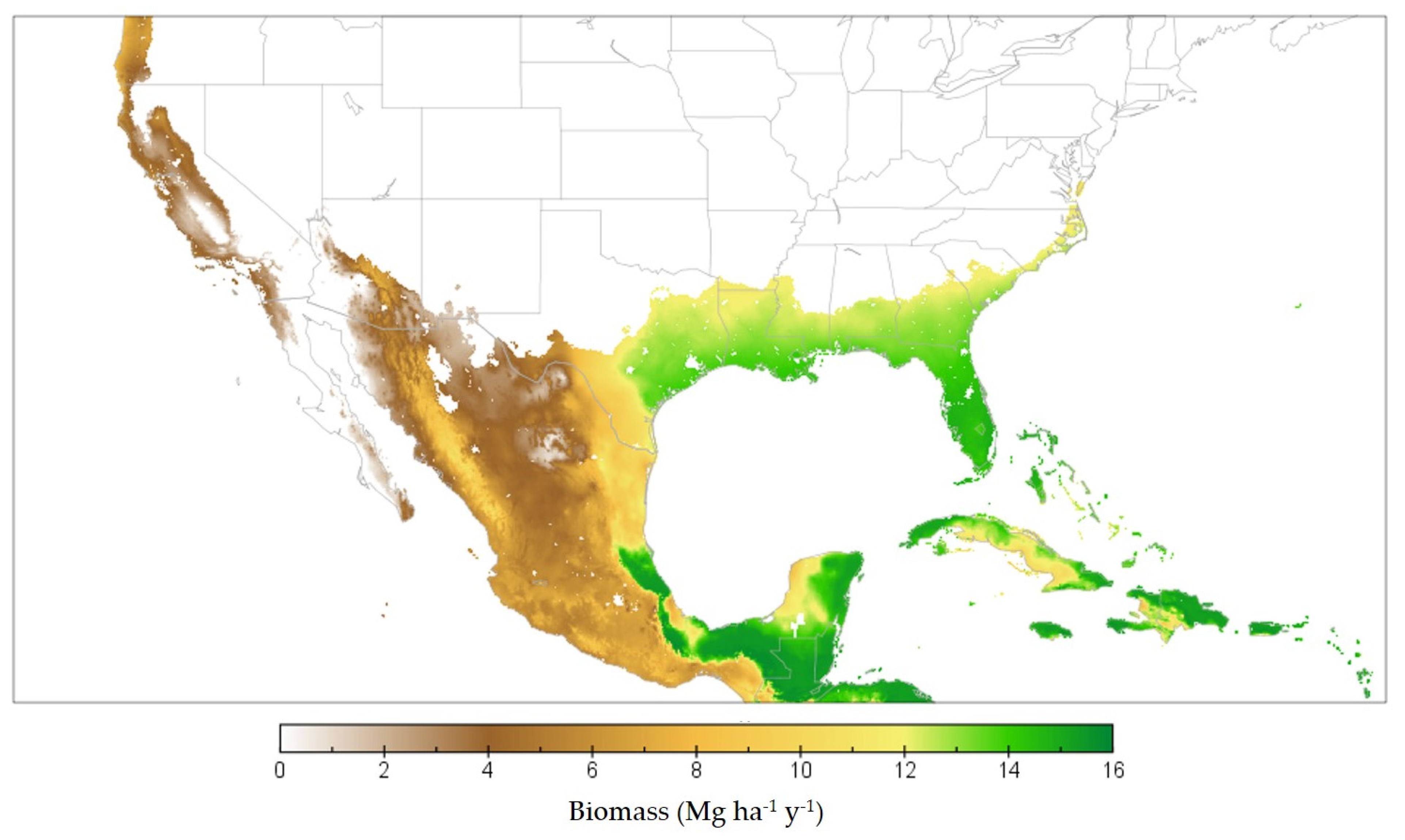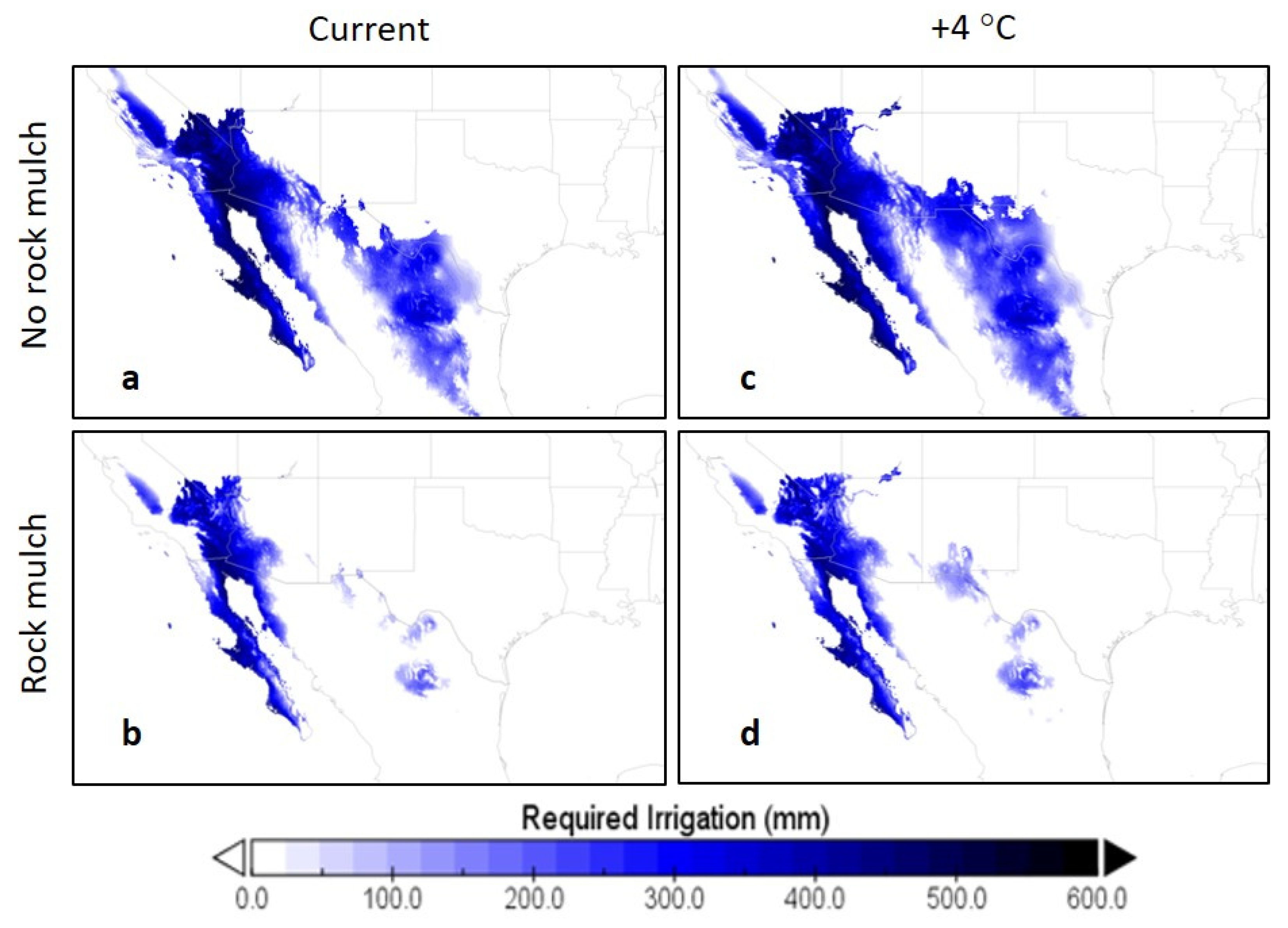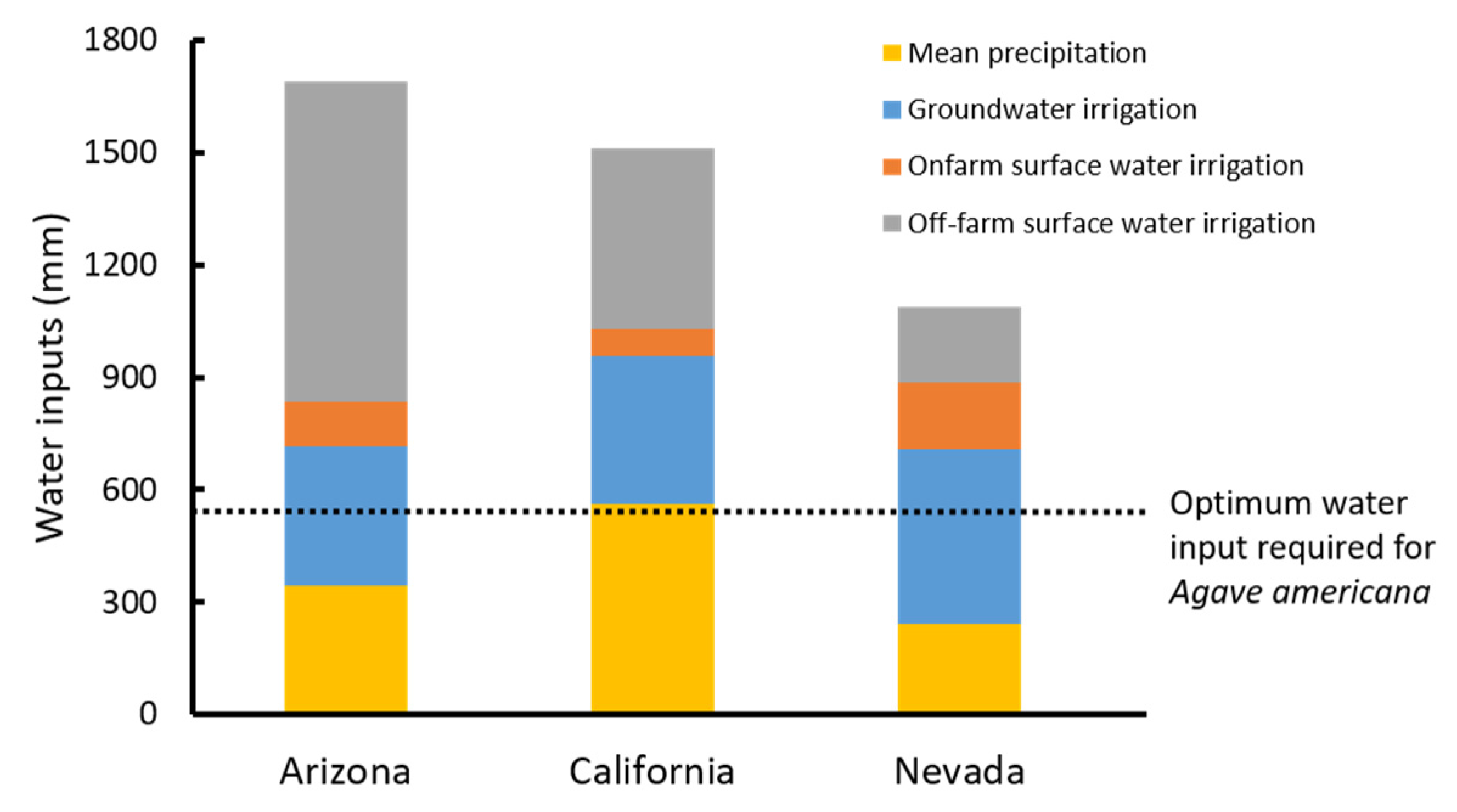Expanded Potential Growing Region and Yield Increase for Agave americana with Future Climate
Abstract
:1. Introduction
2. Materials and Methods
2.1. EPI Model
2.2. Climate Simulations
- Current (1981–2010) climate;
- Climate with 4 °C global warming;
- Current climate with optimal irrigation inputs;
- Climate with 4 °C global warming and optimal irrigation inputs;
- Current climate with rock mulch added (simulated only where rainfed MAP was less than optimum); and
- Climate with 4 °C global warming and rock mulch added (simulated only where rainfed MAP was less than optimum).
2.3. Analysis of Potential Water Requirements in the Southwestern US
3. Results
4. Discussion
5. Conclusions
Supplementary Materials
Author Contributions
Funding
Data Availability Statement
Acknowledgments
Conflicts of Interest
References
- Davis, S.; Kuzmick, E.R.; Niechayev, N.; Hunsaker, D.J. Productivity and water use efficiency of Agave americana in the first field trial as bioenergy feedstock on arid lands. GCB Bioenergy 2017, 9, 314–325. [Google Scholar] [CrossRef]
- Borland, A.M.; Griffiths, H.; Hartwell, J.; Smith, J.A.C. Exploiting the potential of plants with crassulacean acid metabolism for bioenergy production on marginal lands. J. Exp. Bot. 2009, 60, 2879–2896. [Google Scholar] [CrossRef] [PubMed]
- Cushman, J.C.; Davis, S.C.; Yang, X.; Borland, A.M. Development and use of bioenergy feedstocks for semi-arid and arid lands. J. Exp. Bot. 2015, 66, 4177–4193. [Google Scholar] [CrossRef] [PubMed] [Green Version]
- Davis, S.C.; LeBauer, D.S.; Long, S.P. Light to liquid fuel: Theoretical and realized energy conversion efficiency of plants using Crassulacean Acid Metabolism (CAM) in arid conditions. J. Exp. Bot. 2014, 65, 3471–3478. [Google Scholar] [CrossRef] [PubMed] [Green Version]
- Davis, S.C.; Simpson, J.; Gil-Vega, K.D.C.; Niechayev, N.; Van Tongerlo, E.; Castano, N.H.; Dever, L.V.; Búrquez, A. Undervalued potential of crassulacean acid metabolism for current and future agricultural production. J. Exp. Bot. 2019, 70, 6521–6537. [Google Scholar] [CrossRef] [PubMed] [Green Version]
- Davis, S.C.; Dohleman, F.G.; Long, S. The global potential for Agave as a biofuel feedstock. GCB Bioenergy 2010, 3, 68–78. [Google Scholar] [CrossRef]
- Holtum, J.A.M.; Chambers, D.; Morgan, T.; Tan, D.K.Y. Agave as a biofuel feedstock in Australia. GCB Bioenergy 2010, 3, 58–67. [Google Scholar] [CrossRef]
- Lewis, S.M.; Gross, S.; Visel, A.; Kelly, N.M.; Morrow, W. Fuzzy GIS-based multi-criteria evaluation for US Agave production as a bioenergy feedstock. GCB Bioenergy 2014, 7, 84–99. [Google Scholar] [CrossRef] [Green Version]
- Owen, N.A.; Griffiths, H. Marginal land bioethanol yield potential of four crassulacean acid metabolism candidates (Agave fourcroydes, Agave salmiana, Agave tequilana and Opuntia ficus-indica) in Australia. GCB Bioenergy 2014, 6, 687–703. [Google Scholar] [CrossRef]
- Yan, X.; Tan, D.K.Y.; Inderwildi, O.R.; Smith, J.A.C.; King, D.A. Life cycle energy and greenhouse gas analysis for agave-derived bioethanol. Energy Environ. Sci. 2011, 4, 3110–3121. [Google Scholar] [CrossRef]
- Ortiz-Bobea, A.; Ault, T.R.; Carrillo, C.M.; Chambers, R.G.; Lobell, D.B. Anthropogenic climate change has slowed global agricultural productivity growth. Nat. Clim. Chang. 2021, 11, 306–312. [Google Scholar] [CrossRef]
- Ruane, A.C.; Antle, J.; Elliott, J.; Folberth, C.; Hoogenboom, G.; Mason-D’Croz, D.; Müller, C.; Porter, C.; Phillips, M.M.; Raymundo, R.M.; et al. Biophysical and economic implications for agriculture of +1.5° and +2.0 °C global warming using AgMIP Coordinated Global and Regional Assessments. Clim. Res. 2018, 76, 17–39. [Google Scholar] [CrossRef] [PubMed] [Green Version]
- Davis, S.C.; Kloepfer, J.E.; Mayer, J.A.; Cushman, J.C. Diversifying Agriculture with Novel Crop Introduction to Abandoned Lands with Suboptimal Conditions. In Climate Change and Crop Production: Foundations for Agroecosystem Resilience; Benkeblia, N., Ed.; CRC Press: Boca Raton, FL, USA, 2018; pp. 163–172. [Google Scholar]
- Qin, Y.; Abatzoglou, J.T.; Siebert, S.; Huning, L.S.; AghaKouchak, A.; Mankin, J.S.; Hong, C.; Tong, D.; Davis, S.J.; Mueller, N.D. Agricultural risks from changing snowmelt. Nat. Clim. Chang. 2020, 10, 459–465. [Google Scholar] [CrossRef]
- Nobel, P.S. Achievable productivities of certain CAM plants: Basis for high values compared with C 3 and C 4 plants. New Phytol. 1991, 119, 183–205. [Google Scholar] [CrossRef] [PubMed]
- Yan, X.; Corbin, K.R.; Burton, R.A.; Tan, D.K. Agave: A promising feedstck for biofuels in the water-energy-food-environment (WEFE) nexus. J. Clean. Prod. 2020, 231, 121283. [Google Scholar] [CrossRef]
- Fish, S.K.; Fish, P.R.; Miksicek, C.; Madsen, J. Prehistoric agave cultivation in southern Arizona. Desert Plants 1985, 7, 107–112. [Google Scholar]
- Hodgson, W.C.; Salywon, A.M.; Doelle, W.H. Hohokam Lost Crop Found: A New Agave (Agavaceae) Species Only Known from Large-scale pre-Columian Agricultural Fields in Southern Arizona. Syst. Bot. 2018, 43, 734–740. [Google Scholar] [CrossRef] [Green Version]
- Ortiz-Cano, H.; Hernandez-Herrera, J.A.; Hansen, N.C.; Petersen, S.L.; Searcy, M.T.; Mata-Gonzalez, R.; Cervantes-Mendívil, T.; Villanueva-Morales, A.; Park, P.M.; Stewart, J.R. Pre-Columbian Rock Mulching as a Strategy for Modern Agave Cultivation in Arid Marginal Lands. Front. Agron. 2020, 2. [Google Scholar] [CrossRef]
- Diaz, F.; Jimenez, C.; Tejedor, M. Influence of the thickness and grain size of tephra mulch on soil water evaporation. Agric. Water Manag. 2005, 74, 47–55. [Google Scholar] [CrossRef]
- Niechayev, N.A.; Jones, A.M.; Rosenthal, D.M.; Davis, S.C. A model of environmental limitations on production of Agave americana L. grown as a biofuel crop in semi-arid regions. J. Exp. Bot. 2019, 70, 6549–6559. [Google Scholar] [CrossRef] [PubMed]
- Nobel, P. Environmental Biology of Agaves and Cacti; Cambridge University Press: Cambridge, UK, 1988. [Google Scholar]
- Nobel, P.S. Environmental influences on CO2 uptake by agaves, cam plants with high productivities. Econ. Bot. 1990, 44, 488–502. [Google Scholar] [CrossRef]
- Nobel, P.; Smith, J.A.C. High and low temperature tolerances and their relationships to distribution of agaves. Plant Cell Environ. 1983, 6, 711–719. [Google Scholar]
- Abatzoglou, J.T.; Dobrowski, S.; Parks, S.A.; Hegewisch, K.C. TerraClimate, a high-resolution global dataset of monthly climate and climatic water balance from 1958–2015. Sci. Data 2018, 5, 170191. [Google Scholar] [CrossRef] [PubMed] [Green Version]
- Taylor, K.; Stouffer, R.; Meehl, G. An overview of CMIP5 and the experimental design. Am. Meteorol. Soc. 2012, 93, 485–498. [Google Scholar] [CrossRef] [Green Version]
- Gentry, H.S. Agaves of Continental North America; University of Arizona Press: Tucson, AZ, USA, 1982. [Google Scholar]
- Parker, L.; Abatzoglou, J. Projected changes in cold hardiness zones and suitable overwinter ranges of perennial crops over the United States. Environ. Res. Lett. 2016, 11, 034001. [Google Scholar] [CrossRef]
- USDA, United State Department of Agriculture. Economic Research Service 2013 Data Summary. 2020. Available online: https://www.ers.usda.gov/data-products/irrigated-agriculture-in-the-united-states/ (accessed on 29 October 2020).
- National Centers for Environmental Information (Formerly National Climate Data Center). Historical Climatography Series 4-2. 2020. Available online: https://wrcc.dri.edu/Climate/ (accessed on 4 November 2020).
- USDA, United State Department of Agriculture. Risk Management Agency Rainfall Index. 2021. Available online: https://www.rma.usda.gov/en/Policy-and-Procedure/Insurance-Plans/Rainfall-Index (accessed on 20 February 2021).
- Hanak, E.; Escriva-Bou, A.; Gray, B.; Green, S.; Harter, T.; Jezdimirovic, J.; Lund, J.; Medellin-Azuara, J.; Moyle, P.; Seavy, N. Water and the Future of San Joaquin Valley; Public Policy Institute of California: San Francisco, CA, USA, 2019; p. 100. [Google Scholar]
- Jones, A.M.; Zhou, Y.; Held, M.A.; Davis, S.C. Tissue Composition of Agave americana L. Yields Greater Carbohydrates from Enzymatic Hydrolysis Than Advanced Bioenergy Crops. Front. Plant Sci. 2020, 11, 654. [Google Scholar] [CrossRef]
- Monja-Mio, K.M.; Herrera-Alamillo, M.A.; Sánchez-Teyer, L.F.; Robert, M.L. Breeding Strategies to Improve Production of Agave (Agave spp.). In Advances in Plant Breeding Strategies: Industrial and Food Crops; Springer: Cham, Switzerland, 2019; pp. 319–362. [Google Scholar]





| Potential Growing Area (Million ha) | Potential Biomass (Gt) | ||||||
|---|---|---|---|---|---|---|---|
| Climate Scenario | Management | All Land | >3 Mg/ha/y | >10 Mg/ha/y | All Land | >3 Mg/ha/y | >10 Mg/ha/y |
| 1980–2010 | rainfed | 61 | 53 | 27 | 55 | 54 | 36 |
| +4 °C | rainfed | 63 | 55 | 27 | 57 | 55 | 36 |
| 1980–2010 | irrigated | 76 | 77 | 73 | 107 | 107 | 105 |
| +4 °C | irrigated | 79 | 80 | 77 | 111 | 111 | 109 |
| 1980–2010 | rock mulch * | 66 | 60 | 34 | 65 | 64 | 46 |
| +4 °C | rock mulch * | 69 | 63 | 35 | 68 | 67 | 48 |
Publisher’s Note: MDPI stays neutral with regard to jurisdictional claims in published maps and institutional affiliations. |
© 2021 by the authors. Licensee MDPI, Basel, Switzerland. This article is an open access article distributed under the terms and conditions of the Creative Commons Attribution (CC BY) license (https://creativecommons.org/licenses/by/4.0/).
Share and Cite
Davis, S.C.; Abatzoglou, J.T.; LeBauer, D.S. Expanded Potential Growing Region and Yield Increase for Agave americana with Future Climate. Agronomy 2021, 11, 2109. https://doi.org/10.3390/agronomy11112109
Davis SC, Abatzoglou JT, LeBauer DS. Expanded Potential Growing Region and Yield Increase for Agave americana with Future Climate. Agronomy. 2021; 11(11):2109. https://doi.org/10.3390/agronomy11112109
Chicago/Turabian StyleDavis, Sarah C., John T. Abatzoglou, and David S. LeBauer. 2021. "Expanded Potential Growing Region and Yield Increase for Agave americana with Future Climate" Agronomy 11, no. 11: 2109. https://doi.org/10.3390/agronomy11112109
APA StyleDavis, S. C., Abatzoglou, J. T., & LeBauer, D. S. (2021). Expanded Potential Growing Region and Yield Increase for Agave americana with Future Climate. Agronomy, 11(11), 2109. https://doi.org/10.3390/agronomy11112109








